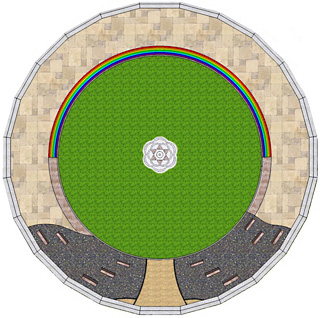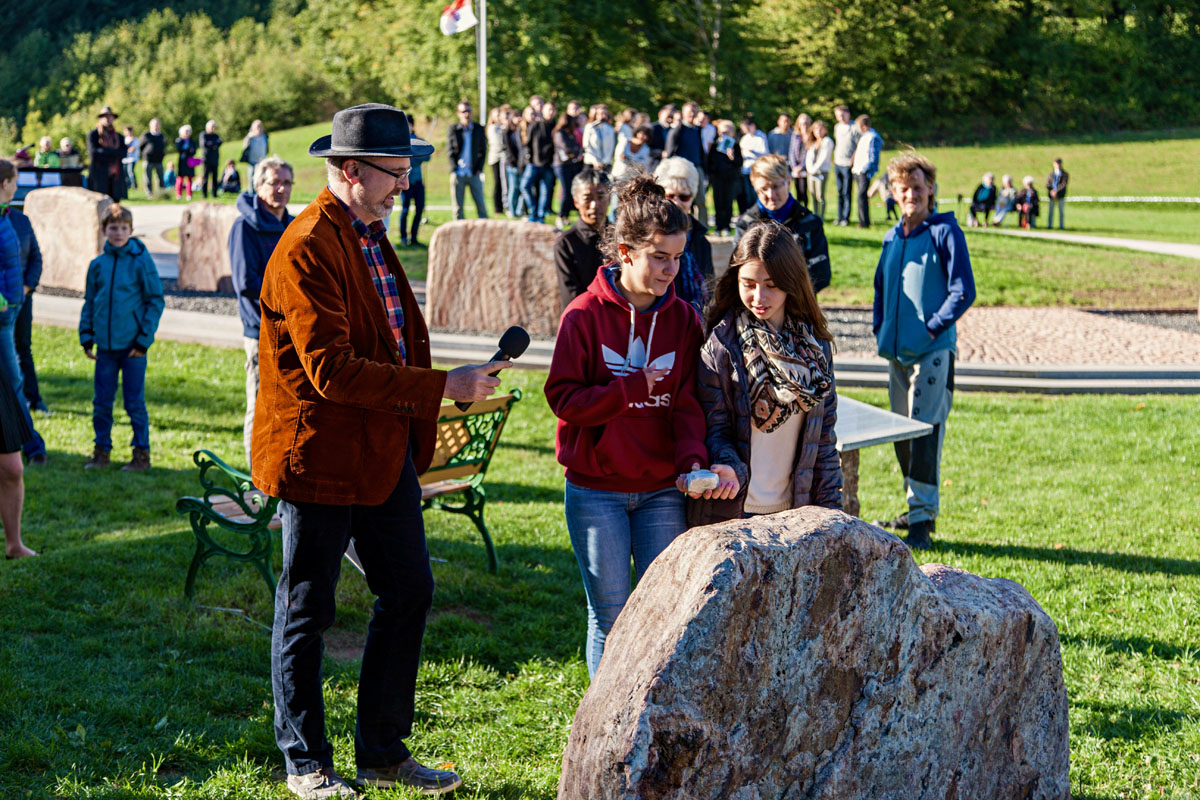Inauguration of the Friedensmal in 2015 with school classes from Israel and Bensheim.
Chapter: Philosophy / The Symbolism
Design elements
The path that leads to the center of the Friedensmal (monument) is the path that people must traverse to reach themselves. The inner peace of people determines the external peace in the world.The Friedensmal shows the Tree of Life, which breaks through a dark ring of 11 commemorative stones as “projection surfaces”. This dark ring symbolizes the vicious cycle of suffering and violence. It is surrounded by the Threshold of Humility, which bears the inscription: “Recognize the sacred in your midst”. This recognition would have prevented the Shoah. If it were recognized today, Germans would not hate their own culture, which is nothing else then a negatively transformed cultural arrogance and which can allow the past to repeat itself – even with all the struggles against this past in retrospect.
Our country often seems to focus heavily on the negative. This can even lead to self-hatred and a rejection of one’s own identity. A society cannot progress if it falls back on the negative to try and develop. It is important to have a motivation, an engagement for life surrounded by love and reason. We need to believe in something good in people to allow it to express itself. Resentment, dissatisfaction, and anger can be detrimental to people, but they can also be transformed into a creative expression for life – the Turning Point inside the Friedensmal – into awakening, courage, and a zest for life. Recognize the potential for good in yourself and others.
The hexagram of the Blossom of Life located at the center of the Tree of Life, is composed of two interlocking triangles. One of them points upwards – from the world to the spirit; the other one points downwards – from the spirit to the world. It is a symbol of the heart, where the upper and lower realms meet.
Numbers
Symbolism has no magical effects, but it helps in understanding. The Friedensmal contains 11 commemorative stones. The 1 symbolizes the will of the one God. The 0 is the absorbing vessel. The 10 also represents God’s creation, which is subject to His will. The 11 adds another will: my own will – being one of God’s creatures (10) – fallen out of the order of the 10. The 11 symbolizes the task to bring one’s one will into line with God’s will again. Thus, every stone in the Friedensmal represents the transformation of suffering, of a burden into a blessing. This means that I want to bring something inside me – in my thinking, feeling, and acting – in line with God’s will again. This is referred to as Tikkun in Jewish Kabbalah. But in contrast to it, as today in liberalism Tikkun Olam is often only understood as an external ideology for the salvation of the world, in the symbolism of the Friedensmal the Tikkun Olam takes place in one's own soul.The 12th stone is located outside of the Friedensmal, which represents inner peace and the detachment from attachment. This 12th stone, the Stone of Encounter, represents a responsibility for peace and freedom in the external world. It is connected to the Friedensmal through the “signpost” pointing towards it. It is made of slate that is installed in the earth in front of the stone. This “signpost” reads: “Where dust is turned to light”
The Tree of Life as a Judeo-Christian symbol
My son, keep my Torah in your memory, and my rules in your heart. She (wisdom) is a Tree of Life to all who take her in their hands, and happy is everyone who keeps her. (Proverbs 3,1 + 18) The Tree of Life
The Tree of LifeThe Tree of Life is one of the main religious symbols of the entire Indo-Germanic culture. The symbol probably arrived in our cultural region from Indonesia, via the Indian Vedic culture. In Judaism, the Torah – instructions of God – are “a Tree of Life”. For Christians, Jesus Christ is the Tree of Life: “I am the Way, the Truth, and the Life; no man comes to the Father, but by me!” (Joh. 14,6). Comment: As I interpret the Bible, this means that someone should become a “Child of God”, to connect as a son or daughter of God "earth and heaven"; like a tree does.
The Tree of Life shows a simplified representation of the crown and trunk of a tree. The roots are located in the dark of the earth, and the branches extend towards the sky. The Tree of Life stands for the inner journey of humans as “Children of God”, connecting the earth with the heaven, the material with the spirit; it’s a journey of love towards becoming heavenly people. It is the inner journey of humans towards themselves – a journey of grace and healing.

The Tree of Life in the Friedensmal
The Tree of Life – or rather: the upper roots and lower trunk – breaks through the dark space. It is the root of the tree that draws up the water from the dark earth and brings up the humus, the earth's soil to be turned into growth, blossoms, and fruit when combined with the air in the leaves.
If the root is holy so are the branches. (Romans 11,16)
No one can be established through wickedness, but the righteous cannot be uprooted. (Proverbs 12,3)
Scripture
But blessed is the one who trusts in the Lord, whose confidence is in him. They will be like a tree planted by the water that sends out its roots by the stream. It does not fear when heat comes; its leaves are always green. It has no worries in a year of drought and never fails to bear fruit. (Jeremiah 17,7-8)
At least there is hope for a tree: If it is cut down, it will sprout again, and its new shoots will not fail. Its roots may grow old in the ground and its stump die in the soil, yet at the scent of water it will bud and put forth shoots like a plant. (Job 14,7-9)
Blessed is the one who does not walk in step with the wicked or stand in the way that sinners take or sit in the company of mockers, but whose delight is in the law of the Lord and who meditates on his law day and night. That person is like a tree planted by streams of water, which yields its fruit in season and whose leaf does not wither - whatever they do prospers. (Psalm 1,1-3)
On each side of the river stood the tree of life, bearing twelve crops of fruit, yielding its fruit every month. And the leaves of the tree are for the healing of the nations. (Revelation 22,2)
Return to overview: Philosophy
